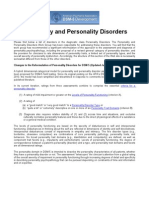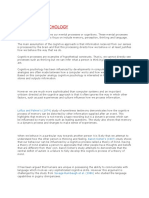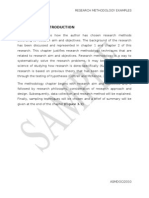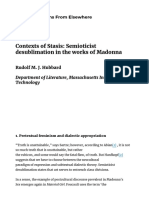11 Psychological Perspectives
11 Psychological Perspectives
Uploaded by
amoraCopyright:
Available Formats
11 Psychological Perspectives
11 Psychological Perspectives
Uploaded by
amoraCopyright
Available Formats
Share this document
Did you find this document useful?
Is this content inappropriate?
Copyright:
Available Formats
11 Psychological Perspectives
11 Psychological Perspectives
Uploaded by
amoraCopyright:
Available Formats
BEHAVIOURAL, EMOTIONAL AND SOCIAL DEVELOPMENT
UNIT 11
PSYCHOLOGICAL PERSPECTIVES ON BEHAVIOUR
LEARNING OBJECTIVES
Teachers will:
Identify different psychological perspectives on behaviour and recognise how
different perspectives influence the identification of BESD and subsequent
interventions
Know how different psychological perspectives are reflected in school behaviour
policies
Consider the relative strengths and weaknesses of adopting particular
psychological perspectives in different situations.
ONLINE RESOURCES
The content and tasks throughout these PDFs are supported by online resources
that are designed to facilitate and supplement your training experience.
Links to these are signposted where appropriate. The resources use graphics and
interactive elements to:
Highlight salient points
Provide at-a-glance content summaries
Introduce further points of interest
Offer visual context
Break down and clearly present the different stages and elements of processes,
tasks, practices, and theories
The online resources offer great benefits, both for concurrent use alongside the
PDFs, or as post-reading revision and planning aids.
Please note that the resources cannot be used in isolation without referencing the
PDFs. Their purpose is to complement and support your training process, rather than
lead it.
You should complete any learning or teaching tasks and additional reading detailed
in this PDF to make full use of the Advanced training materials for autism; dyslexia;
speech, language and communication; emotional, social and behavioural difficulties;
moderate learning difficulties.
To find out more about the resources, how they work, and how they can enhance
your training, visit the homepage at: www.education.gov.uk/lamb
1 Crown copyright 2012
The first resource for this unit can be found here:
www.education.gov.uk/lamb/besd/psychological-perspective/intro
BRIEFING
Approaches to understanding and managing behaviour have been informed by a
number of different psychological perspectives, some of which are based on well-
established theories.
Knowledge of these perspectives can contribute to a better-informed response to
pupils behaviour. Specifically, they can contribute to:
initial identification and assessment of behaviour, and
the choice of intervention.
It is not necessary to view any one perspective as exclusive as some will be more
relevant to individual cases than others, thus enabling a choice of approach
according to the context in which the behaviour occurs.
This briefing provides an introductory overview of the range of approaches for
understanding and managing behaviour. These are:
Psychodynamic
Behaviourist
Cognitive
Humanist
Ecosystemic.
The psychodynamic perspective
This perspective is based on the early work of Sigmund Freud1 and takes as its main
precept, the belief that behaviour is governed by subconscious feelings which arise
from early life experiences. It views children's problem behaviour as an outward and
visible symptom of internal and invisible conflicts. These conflicts may arise from
early trauma or loss or from a troubled relationship with parents or carers. Children
do not have the inner resources to be able to process and digest their troubled
feelings fully and these may be expressed in inappropriate and difficult behaviour.
When a childs too painful or too difficult feelings are left untalked about, they
leak out in difficult and challenging behaviour or in neurotic symptoms.
Sometimes, the source of a painful feeling is buried so deeply under defensive
mechanisms that it is very hard to find. Consequently, pupils may not understand
why they are behaving in this way.
Psychodynamic assessment is carried out by trained professional, such as
psychiatrist or psychoanalytic counsellors, using techniques designed to provide
insight into past conflicts. This uses the responses of the pupil to make inferences
about underlying and sub-conscious motives for behaviour.
1
Freud, S (1984) The Unconscious in Richards, A The Pelican Freud Library, Vol. 11. The Theory of
Psychoanalysis. Harmondsworth, Penguin (Original work pubd 1915).
2 Crown copyright 2012
Interventions based on the results of a psychodynamic assessment:
Build up pupils inner resources and sense of security such that they can give up
any defensive negative behaviour
Build supportive relationships, especially with a significant adult
Enable pupils to talk about their feelings in an appropriate and secure
environment e.g. expressing painful feeling through drama, storytelling, play, film
scripts or cartoons.
The behaviourist perspective
This perspective is based on the work of psychologists Watson (1930)2, Skinner
(1953)3 and Thorndike (1932)4. The main principle, as expressed in Thorndikes
Law of Effect, is that behaviour that leads to satisfaction is strengthened and
behaviour which is ignored or is unsatisfying is weakened. Behaviourist theory
claims that all behaviour is learned and can therefore be modified by a system of
rewards and punishment.
The behaviourist movement, which originated in America early in the last century,
evolved in part as a reaction to the Freudian school in Vienna. Anxious to present
the new science of psychology as a scientific method, they claimed that the study of
behaviour requires a scientific approach based on objectivity and experimentation.
The introspective methods (i.e. hypothesising about what is going on inside
someones head, as used by the Freudian school) were considered to be
unscientific. Instead, emphasis was placed on observable and measurable
behaviour, rather than a search for causes hidden in an individuals past.
Behavioural assessment in school involves the systematic observation and recording
of the antecedent conditions and consequences that surround particular behaviours.
This is then recorded on observation checklists (ABC5 antecedent, behaviour,
consequences) to form an initial assessment. This can also be used as a baseline
from which post-intervention behaviour can be assessed.
The aim of this systematic approach is to avoid:
Intuitive judgements about the frequency of a particular behaviour, and
Inaccurate evaluation of improvements in behaviour based on perceptions that
may be biased.
Behavioural interventions or behaviour modification programmes aim to change
behaviour patterns by offering positive reinforcements for appropriate behaviours
and negative consequences for inappropriate behaviours.
Rewards may be:
2
Watson, J. B. (1930). Behaviorism (revised edition). University of Chicago Press.
3
Skinner, B.F. (1953). Science and Human Behavior. New York: Macmillan.
4
Thorndike, E. L. (1932). The Fundamentals of Learning. New York, NY, US: Teachers College Bureau of
Publications.
5
for an explanation of the ABC approach see BESD, TDA Self-study Task 9, Activity 3
3 Crown copyright 2012
Informal (e.g. acknowledgement or praise) or
Formal (e.g. behavioural contracts which establish clear targets leading to
stickers, tokens, points etc. leading to larger rewards).
The Cognitive perspective
This perspective suggests that individual cognitive processes, such as reasoning,
understanding and interpretation of events influence behaviour most. The cognitive
approach goes some way to addressing the question Why does the same stimulus
produces different responses in different people?
The main cognitive influences on behaviour are considered to be pupils:
View of themselves
Understanding of their behaviour and how this affects other people
Views of who is responsible for the behaviour
Goals - what are they trying to achieve?
A cognitive approach maintains that problem behaviour may develop when pupils
misperceive and misconstrue a situation, so that they respond in a way that seems
appropriate and rational to them, but inappropriate to other people who see the
situation differently. Behaviour can be changed if attitudes, expectations and beliefs
are understood and adapted.
A cognitive perspective differs from a psychodynamic perspective, because it does
not refer to unconscious processes; rather it refers to conscious awareness and
thinking and reasoning about the current situation. It is also unlike a behavioural
perspective in that it refers to non-observable cognitive events which cannot easily
be measured.
Cognitive assessment in schools is likely to be through the use of self-monitoring
logs and self-reports or interviews so that pupils can describe the thoughts that are
associated with a particular behaviour The aim is to understand behaviours from the
pupils point of view.
The aim of cognitive interventions in school is to clarify and challenge
misperceptions, attributions and attitudes and to give pupils some control of their
behaviour. For example an intervention such as an Anger Management programme
aims to give the pupil more control over his behaviour by helping him to understand
the triggers which lead to angry outbursts and to recognise alternative responses
which are more socially acceptable6.
Much of the work on teaching Emotional Literacy in schools is aimed at pupils
developing a better understanding of their own behaviour and how it affects others.
The Humanist perspective
This developed from the work of Abraham Maslow and Carl Rogers7. In 1957 and
1958, at the invitation of Maslow and Rogers, two meetings were held in Detroit
6
See Unit 13: Understanding and Managing Anger
7
Rogers, C. (1974) On becoming a person, London: Constable.
4 Crown copyright 2012
among psychologists, who were interested in founding a professional association
dedicated to a more humanistic vision. Maslow and his colleagues came to refer to
their movement as third force psychology, the first two forces being psychoanalysis
and behaviourism. The third force is based on philosophies of existentialism and
humanism
Behaviourists recognise only one motivation for behaviour (i.e. to maximise those
experiences that result in positive reinforcement). Humanists, however, take into
account other very important drivers, which they consider to be essential for human
development. These are the need:
To belong to a social group
To think well of oneself
For personal growth.
In his diagrammatic pyramid of the hierarchy of human needs (below), Abraham
Maslow places the most basic needs - physiological needs such as hunger and thirst
and safety needs - at the bottom of the pyramid. Next come the need to belong and
the need to think well of oneself. At the top is self-actualisation, which is interpreted
as the need to fulfil oneself (i.e. to become all that one is capable of becoming).
From Maslow's perspective, the drive to learn is intrinsic and the purpose of learning
is to bring about self-actualisation. An individual is ready to act in relation to a level of
need only when the previous levels of need have been met. For many pupils,
especially those with BESD, the need to belong to a group and the need to think well
of oneself are needs that may not have been met at home or in their school careers.
According to Maslow, therefore, for these pupils, the drive to self-actualisation is
unlikely to be recognised.
5 Crown copyright 2012
Humanist interventions in schools focus on addressing the hierarchy of need and
developing self-esteem and a sense of belonging. Interventions, such as counselling,
involve working with pupils to help them learn alternative ways of perceiving and
interpreting themselves and their world which will enable them to be less dependent
on those around them for a sense of worth and consequently more resilient to
troubling factors in their lives.
We should recognise that the misbehaving child is only trying to find his
place: he is acting on the faulty logic that his behaviour will give him the social
acceptance he desires8.
The Ecosystemic perspective
This perspective is based on the idea of an ecosystem, in which even quite small
changes in any part of the ecosystem, will bring about related changes elsewhere.
The theoretical origins of the Ecosystemic perspective of human behaviour rest in
the work of Ludwig von Bertalanffy (1968)9. Molnar and Lindquist (1989)10 have
applied the model to schools and classrooms.
An ecosystemic approach offers new ways of conceptualising behavioural problems
in schools and is based on the view that human behaviour is developed and
maintained through interactional processes.
Key features of the ecosystemic approach to behaviour are that:
problem behaviour does not originate from within the individual, who displays it,
but is a product of social interaction
the cause of any instance of problem behaviour is part of a cyclical chain of
actions and reactions between participants.
Behaviour problems are, thus, the product of interactions between teachers, pupils
and families or between pupils themselves, and these interactions occur in certain
contexts. Teachers, pupils and families can become locked into a pattern of negative
circular interaction leading to deteriorating behaviour. Behavioural change can,
therefore, occur only through focusing on the context as well as the individuals.
Ecosystemic assessment requires teachers to examine their interpretations of their
interactions with pupils, other teachers and parents. The focus is on interpretation
and attribution at a particular time and in a particular context (e.g. in a peer group, in
the classroom, in the playground or at home).
8
Dreikurs, R. et al.1998. Maintaining Sanity in the (Classroom (2nd ed.) Philadelphia: Taylor and Francis
9
Bertalanffy, L.von (1968) General Systems Theory: Foundation, Development, Applications. New York:
Braziller
10
Molnar, A. & Lindquist, B. (1989) Changing problem behaviour in schools. San Francisco: Jossey-Bass
6 Crown copyright 2012
Ecosystemic interventions in school focus on the idea that there are different, equally
valid, interpretations of the same behaviour or situation. Teachers and pupils need to
look for a positive interpretation in order to reframe the behaviour and so break out
of the negative cyclical chain of actions and reactions between participants. The aim
of reframing is for both teacher and pupils to view the problem behaviour in a new
and more positive light. This might involve describing the behaviour in neutral and
observable terms, identifying positive contributions that the pupil makes and creating
a new positive perspective which the pupil can act on.
See online resource:
www.education.gov.uk/lamb/besd/psychological-perspective/perspectives
Psychological perspectives in schools
Frederickson and Cline11 report the percentages of each type of strategy
recommended by educational psychologies in one local authority in one school term:
Behavioural strategies were most frequently used
The use of behavioural strategies was reported about three times more often in
primary than secondary schools
Counselling and other cognitive interventions were more frequently implemented
in secondary schools than in primary.
See online resource:
www.education.gov.uk/lamb/besd/psychological-perspective/perspectives-schools-
data
TASKS
1. Listening to staff talking about pupils you may identify the different
perspectives on behaviour which influence their comments. Can you identify
the perspectives that the teachers might be adopting in the following
comments by matching them to perspectives described in the previous
section?
Michaels behaviour improves when he is given a smiley face for sitting
quietly.
Marias aggressive outbursts seem to occur mostly in the playground after
lunch break.
Toby is withdrawn and emotionally insecure, he has had a difficult
relationship with his father.
Lucy is now able to talk about the reasons she feels angry and to identify
the triggers which make her lose her temper in class.
2. It is not necessary to view any one perspective as exclusive as some
perspectives will be more relevant to individual cases than others, thus
11
Frederickson & Cline (2009) Special Educational Needs and Diversity. Maidenhead: Open University Press
7 Crown copyright 2012
enabling a choice of approach according to the context in which the behaviour
occurs.
Use the table below to list of the relative strengths and weaknesses of the
various psychological perspectives and think about the type of situations,
dealing with pupils with BESD, in which you might decide to adopt an
approach based on that perspective.
Perspective Strengths ...think of a Weaknesses ...think of a
situation in situation in
which you which this
would find this approach
approach would not be
helpful helpful
Psycho-
dynamic
Behavioural
Cognitive
Humanist
Ecosystemic
8 Crown copyright 2012
3. Read your school behaviour policy and identify the perspectives that inform
the strategy. Is it dominated by one perspective or does it reflect a range of
perspectives?
4. Talk to a colleague about a pupil with BESD with whom he or she requires
support. Identify the main perspective or perspectives that your colleague is
taking on the pupils behaviour. What kinds of interventions might you
suggest?
REFERENCES
Ayers et al. (2001) Perspectives on Behaviour: A practical guide for effective
interventions for teachers (2nd ed) London: David Fulton
Bertalanffy, L.von (1968) General Systems Theory: Foundation, Development,
Applications. New York: Braziller
Dreikurs, R. Et al (1998) Maintaining Sanity in the Classroom (2nd ed) Philadelphia:
Taylor and Francis
Frederickson & Cline (2009) Special Educational Needs and Diversity. Maidenhead:
Open University Press
Freud, S (1984) The Unconscious in Richards, A The Pelican Freud Library, Vol. 11.
The Theory of Psychoanalysis. Harmondsworth, Penguin (Original work pubd
1915).
Molnar, A. & Lindquist, B. (1989) Changing problem behaviour in schools. San
Francisco: Jossey-Bass
Rogers, C. (1974) On becoming a person, London: Constable.
Skinner, B.F. (1953). Science and Human Behavior. New York: Macmillan.
Thorndike, E. L. (1932). The Fundamentals of Learning. New York, NY, US:
Teachers College Bureau of Publications.
Watson, J. B. (1930). Behaviorism (revised edition). University of Chicago Press.
9 Crown copyright 2012
You might also like
- Compare and Contrast Two Psychological ApproachesDocument3 pagesCompare and Contrast Two Psychological Approachesmandlovhu100% (4)
- Psychology - Theoretical Approaches and Applications PDFDocument248 pagesPsychology - Theoretical Approaches and Applications PDFGracy Jebastina100% (1)
- Final Syllabus Forensic Psychology Spring 2016Document6 pagesFinal Syllabus Forensic Psychology Spring 2016Karla PereraNo ratings yet
- Addie Vs AssureDocument10 pagesAddie Vs AssureCML78100% (1)
- Extensive and Intensive ResearchDocument6 pagesExtensive and Intensive ResearchWilliam Molnar100% (1)
- Fundamentals of PsychologyDocument3 pagesFundamentals of PsychologyShilpakala VasudevanNo ratings yet
- Chap 3 Sensation and PerceptionDocument55 pagesChap 3 Sensation and PerceptionWenJun LeowNo ratings yet
- The Dark Side of Emotional IntelligenceDocument4 pagesThe Dark Side of Emotional IntelligenceKev Gianfranco MazaNo ratings yet
- A Closer Look at Cognitive Psychology: BehaviorismDocument3 pagesA Closer Look at Cognitive Psychology: Behaviorismtushu menkaNo ratings yet
- PYC 1501 Basic Psychology - EmotionsDocument7 pagesPYC 1501 Basic Psychology - Emotionsektha_nankoomar91100% (7)
- Introduction of PsychologyDocument15 pagesIntroduction of PsychologySylvianaNo ratings yet
- Unit 2 Abnormal PsychologyDocument44 pagesUnit 2 Abnormal PsychologyMohammed SaniNo ratings yet
- Forensic Psychology Lesson PlanDocument19 pagesForensic Psychology Lesson PlanBoNo ratings yet
- Fundamentals of Psychology 202110 - Lecture 1Document36 pagesFundamentals of Psychology 202110 - Lecture 1KITTIVONGSAK VONGSUTHEP KEITHNo ratings yet
- Abnormal PsychologyDocument27 pagesAbnormal Psychologymulugeta100% (1)
- Schizophrenia - Sick search engine the brain: Neurotic-psychotic developments: When the soul "googles" and the memory delivers increasingly irrational search resultsFrom EverandSchizophrenia - Sick search engine the brain: Neurotic-psychotic developments: When the soul "googles" and the memory delivers increasingly irrational search resultsNo ratings yet
- ARTHASHASTRADocument36 pagesARTHASHASTRAAnu RajNo ratings yet
- Abnormal Psychological and Mental IllnessDocument3 pagesAbnormal Psychological and Mental IllnessAleena KhanNo ratings yet
- Personality CorrectionDocument35 pagesPersonality CorrectionnimishasruthNo ratings yet
- 1.foundation of Applied PsyDocument21 pages1.foundation of Applied PsyAhmad AbdullahNo ratings yet
- Branches and Fields of PsychologyDocument15 pagesBranches and Fields of PsychologypappuNo ratings yet
- Cross Cultural Research MethodsDocument36 pagesCross Cultural Research MethodsJoanna MabutotNo ratings yet
- Discursive PsychologyDocument11 pagesDiscursive PsychologybnamamNo ratings yet
- Psychological Disorders: AP Psychology Mr. HollandDocument20 pagesPsychological Disorders: AP Psychology Mr. Hollandyummywords1254No ratings yet
- Social Psychology Study Notes - Unit 1.Document13 pagesSocial Psychology Study Notes - Unit 1.Sakshi BaisNo ratings yet
- A2 Psychology Revision GuideDocument17 pagesA2 Psychology Revision GuideShilpa KantariaNo ratings yet
- Psychoanalysis: Some of The Basic Tenets of PsychoanalysisDocument7 pagesPsychoanalysis: Some of The Basic Tenets of Psychoanalysistaran singhNo ratings yet
- Personality TheoriesDocument18 pagesPersonality Theoriesapi-461452779No ratings yet
- Dynamics of PersonalityDocument108 pagesDynamics of PersonalityAslina AzibNo ratings yet
- Durkheim - The Dualism of Human Nature and Its Social ConditionsDocument16 pagesDurkheim - The Dualism of Human Nature and Its Social ConditionsJulio Santos FilhoNo ratings yet
- Psychology PDFDocument4 pagesPsychology PDFCky 8899No ratings yet
- Psychology Is The Study Of: PractitionerDocument34 pagesPsychology Is The Study Of: PractitionerSushmita SahuNo ratings yet
- Psychology of AdjustmentDocument30 pagesPsychology of AdjustmentROCHAK PARIDANo ratings yet
- Cognitive PsychologyDocument7 pagesCognitive PsychologyAshu KoolNo ratings yet
- APA - (2011) DSM-5 Development. Personality and Personality DisordersDocument16 pagesAPA - (2011) DSM-5 Development. Personality and Personality DisordersRodrigo Middleton InfanteNo ratings yet
- Joydeep Bhattacharya (MACP) Preethi Balan (PGDCP) Sanyogita Soni (PGDCP) Sutapa Choudhury (PGDCP)Document20 pagesJoydeep Bhattacharya (MACP) Preethi Balan (PGDCP) Sanyogita Soni (PGDCP) Sutapa Choudhury (PGDCP)Tariq JaleesNo ratings yet
- Introduction To Psychology (Basic Information)Document5 pagesIntroduction To Psychology (Basic Information)EileenNo ratings yet
- PET Psychology Module 1Document9 pagesPET Psychology Module 1Oana DumbravaNo ratings yet
- Hans Eysenck's Personality TheoriesDocument4 pagesHans Eysenck's Personality TheoriesSempiternalNo ratings yet
- QR NotesDocument88 pagesQR NotesBalaji Ravichandran100% (1)
- Introduction To Psychology: Case Study MethodDocument10 pagesIntroduction To Psychology: Case Study MethodUkhadi 2525No ratings yet
- Introduction To PsychologyDocument783 pagesIntroduction To Psychologyhednin100% (1)
- Cognitive Psychology: Loftus and Palmer's (1974)Document10 pagesCognitive Psychology: Loftus and Palmer's (1974)jocelyno0100% (1)
- Psyc 1000 Finals NotesDocument255 pagesPsyc 1000 Finals NotesnoobzthomasNo ratings yet
- Psychodynamic Approach: The BasicsDocument2 pagesPsychodynamic Approach: The Basicssreekanthreddy peram0% (1)
- Moral Emotions and Moral BehaviorDocument27 pagesMoral Emotions and Moral BehaviorCătălina PoianăNo ratings yet
- What Is Psychology?: Chapter OneDocument60 pagesWhat Is Psychology?: Chapter OneMaithri Jagirdar100% (1)
- Abnormal Psychology: Jeanne M. Slattery, PH.DDocument5 pagesAbnormal Psychology: Jeanne M. Slattery, PH.DCristina GhermanNo ratings yet
- Introducing Social PsychologyDocument10 pagesIntroducing Social Psychologydevyani rathodNo ratings yet
- Introduction To - PsychologyDocument44 pagesIntroduction To - PsychologyAmrita KanchanNo ratings yet
- Psyc HandoutDocument85 pagesPsyc HandoutPhilipose DaNielNo ratings yet
- Kecemasan Generalized Anxiety DisorderDocument16 pagesKecemasan Generalized Anxiety DisorderMuh AfdholNo ratings yet
- PSYCHOLOGYDocument12 pagesPSYCHOLOGYMichelle GoNo ratings yet
- Rotter's Theory of PersonalityDocument1 pageRotter's Theory of Personalitygayyer100% (3)
- Psychology Lecture 2 2020 2021Document3 pagesPsychology Lecture 2 2020 2021Oussama HarizNo ratings yet
- Applications of PsychologyDocument22 pagesApplications of PsychologymehnaazNo ratings yet
- 8 Social Cognitive TheoryDocument3 pages8 Social Cognitive Theorycharmen rogandoNo ratings yet
- Banduras TheoryDocument2 pagesBanduras TheorySandra MedinaNo ratings yet
- Genral Psychology AssignmrntDocument9 pagesGenral Psychology Assignmrntnigush865No ratings yet
- Albert BanduraDocument4 pagesAlbert BanduraJonna Mae QuinoneroNo ratings yet
- October 8 BAtu Bela Bertangkup Lpfor ScribDocument3 pagesOctober 8 BAtu Bela Bertangkup Lpfor ScribAida AguilarNo ratings yet
- Five Central Cognitive Processes in IL DevelopmentDocument3 pagesFive Central Cognitive Processes in IL DevelopmentLorena Vega LimonNo ratings yet
- Hayashi Noticing of DepartureDocument30 pagesHayashi Noticing of DepartureidschunNo ratings yet
- Poetic Truth For Utopian and Fairy TaleDocument4 pagesPoetic Truth For Utopian and Fairy TalejoecerfNo ratings yet
- Distributed Leadership According To EvidenceDocument17 pagesDistributed Leadership According To Evidenceapi-352539012No ratings yet
- Reflection AssignmentDocument2 pagesReflection Assignmentapi-240780982No ratings yet
- Dennis - Symbolic Interactionism and The Concept of PowerDocument23 pagesDennis - Symbolic Interactionism and The Concept of PowerPete SamprasNo ratings yet
- Masters - Brief Rev01 - Low PDFDocument6 pagesMasters - Brief Rev01 - Low PDFJack GillbanksNo ratings yet
- Lesson Plan VolleyballDocument4 pagesLesson Plan VolleyballJasmine Mariebenj VidalNo ratings yet
- Grade 11 Curriculum Guide PDFDocument3 pagesGrade 11 Curriculum Guide PDFChrisNo ratings yet
- Functions, Features, and Barriers To CommunicationDocument5 pagesFunctions, Features, and Barriers To CommunicationKat PingolNo ratings yet
- Positive Self TalkDocument2 pagesPositive Self TalkDaniel BernalNo ratings yet
- Lesson 1 What Ethics IsDocument7 pagesLesson 1 What Ethics IsJonas MonteroNo ratings yet
- Using Concept Map Knowledge Management System To Enhance The Learning of BiologyDocument3 pagesUsing Concept Map Knowledge Management System To Enhance The Learning of Biologyapi-289847675No ratings yet
- Can Ethics Be Taught?Document6 pagesCan Ethics Be Taught?David LuqueNo ratings yet
- Anderson - Neo-Kantianism and The Roots of Anti-PsychologismDocument38 pagesAnderson - Neo-Kantianism and The Roots of Anti-PsychologismPete SamprasNo ratings yet
- 1st Grade Respect LessonDocument2 pages1st Grade Respect Lessonapi-242270654No ratings yet
- 6 Week Sed Prof 311 Module 6 - Foundations of Curriculum DevelopmentDocument7 pages6 Week Sed Prof 311 Module 6 - Foundations of Curriculum DevelopmentaetheticNo ratings yet
- Example 1: 3.1. Chapter IntroductionDocument68 pagesExample 1: 3.1. Chapter IntroductionRajeshwari Katkam75% (4)
- Chapter I: The ProblemDocument39 pagesChapter I: The ProblemKryzella ManaoisNo ratings yet
- Creative Thinking Reframing and Mind Mapping PDFDocument4 pagesCreative Thinking Reframing and Mind Mapping PDFrajiNo ratings yet
- Student Outline 2011 Semester TwoDocument2 pagesStudent Outline 2011 Semester TworoslyngreenNo ratings yet
- Chapter 5 Powerpoint With Extra SlidesDocument111 pagesChapter 5 Powerpoint With Extra Slidesmonster40lbsNo ratings yet
- The Designer Method of 1970 SDocument10 pagesThe Designer Method of 1970 SYolly LaderaNo ratings yet
- Science Education and Scientific Attitudes: Pravin SinghDocument6 pagesScience Education and Scientific Attitudes: Pravin SinghMuhamad Yutam SolehNo ratings yet
- Thematic Progression Patterns in The IELTS Task 2 WritingDocument6 pagesThematic Progression Patterns in The IELTS Task 2 WritingJOURNAL OF ADVANCES IN LINGUISTICSNo ratings yet
- Hubbard - Contexts of Stasis - Semioticist Desublimation in The Works of MadonnaDocument7 pagesHubbard - Contexts of Stasis - Semioticist Desublimation in The Works of MadonnaTerras e LutasNo ratings yet
- Parfit - Personal Identity and RationalityDocument15 pagesParfit - Personal Identity and RationalityAlma Rosa Garza100% (1)

























































































